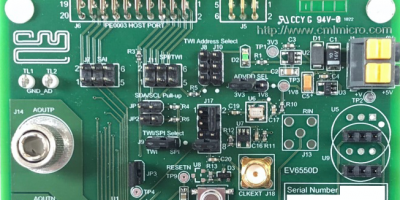Low power voice codecs suit always on voice applications
Aimed at existing telephony and emerging high quality speech applications in ‘smart’ devices, the CMX655D is described by CML Microcircuits as the next generation in voice codecs. According to the company, it marks a “significant evolution” in voice codecs, which brings greater integration at low power to enable advanced features in a range of applications.
The CMX655D integrates two matched channels with DSP along with a 1.0W 90 per cent efficient filterless Class D amplifier and support for digital MEMS microphones. Conventionally, these functions would have only been possible by adding additional components. Manufacturing processes result in a device that requires very low power in all operating modes and is able to operate from a 1.8 to 3.6V supply as opposed to requiring 5V to achieve a 1.0Watt output. This makes the CMX655D particularly well suited to battery-powered devices.
Voice codecs are the interface between a microphone and a speaker in wired and wireless telephony, using voice as an interface. The smartphone industry focuses on multimedia codecs, yet CML believes the demand for higher quality voice outside this market is also increasing, as consumers become more accustomed to interfacing with advanced electronic devices using their voice. As well as higher quality audio in telephony, the use of natural speech and audible feedback in devices such as home appliances and digital assistants is increasing as devices become ‘smart’ and interactive.
Manufacturers are increasingly turning to signal processing to apply digital filters to voice signals. This would normally require either a separate DSP or a high-end microcontroller. The CMX655D’s integrated DSP functionality allows OEMs to remove the external DSP or specify a low-end microcontroller instead. The CMX655’s low power operation requires around 500 microA for all microphone path functions, as opposed to a few mA required by alternative codecs.
The low power and high level of integration will enable manufacturers to add high quality voice to a wider range of applications, such as intercom-based door entry units and other security systems, smart home appliances and voice systems in the home, workplace and factory. It will also offer significant benefits to existing telephony applications, says CML.
The CMX655D features two independent microphone channels capable of operating in full duplex mode while maintaining relative signal phase, enabling one device to support two-way communication while simultaneously applying echo cancellation, for example. The voice filters offered by the DSP include 300Hz to 3.4kHz for classic telephony and 50Hz to 7kHz for high definition audio, while all signal paths supports audio bandwidths up to 21kHz at sample rates of eight, 16, 32 or 48k samples per second.
As a traditional telephony codec, the CMX655D supports A-law and micro-law companding. The two parallel channels feature completely separate signal paths but share a common serial audio interface, which supports I2S (the inter-IC sound serial bus designed for digital audio devices) as well as SPI and I2C interfaces for device control.
The speaker path has dynamic range control ensures a constant volume at the output speaker even if the input varies. This can be a particularly useful feature in intercom or security systems, points out CML.
The CMX655D is supported by a range of development tools including the EV6550D evaluation kit and is available now in a small 4.0 x 4.0mm QFN package.
http://www.cmlmicro.com

